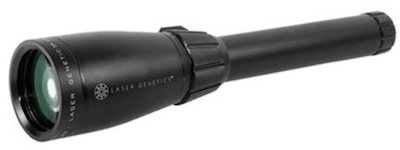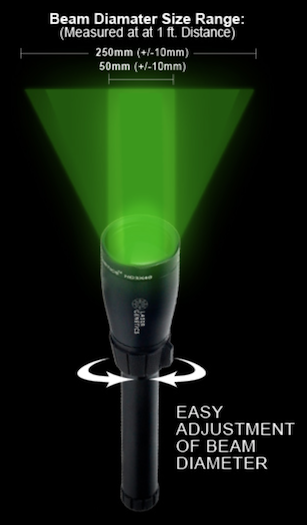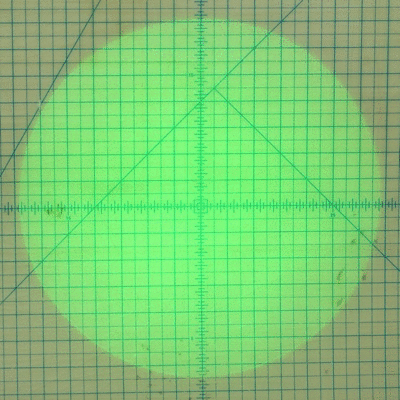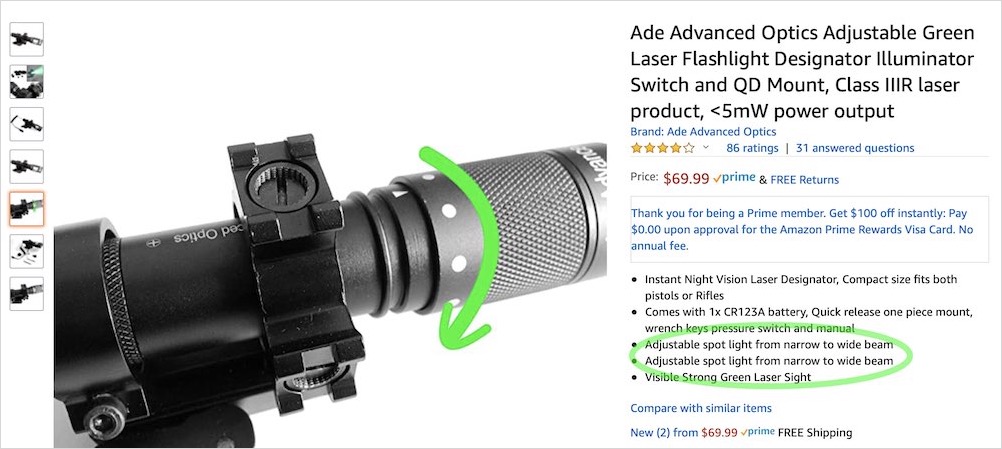Home
A comprehensive resource for safe and responsible laser use

Laser designator ‘flashlights’
A laser designator is essentially a laser with an expanded beam like a flashlight. The beam is useful for military and civilian uses in shooting, spotting, search & rescue, and as a “night vision” hunting light source whose color may be not noticeable to many animals.
A designator’s beam should have a smooth, uniform profile. It should not have a bright center gradually fading to a dim edge.
Using a laser designator for demonstrations
When presenting demonstrations about laser hazards to pilots, at LaserPointerSafety.com we use both standard laser pointers and a high-quality laser designator. The particular designator we use is a Laser Genetics LD*3 x40 which was purchased for around USD $150.

The beam can be focused wide, narrow or any size in-between:

The output is a smooth circle of laser light, including speckle. (For a simulation of laser speckle, see "What the light looks like" on the page How to safely simulate a laser strike.) The size of the circle varies depending on the beam diameter adjustment and the distance to a wall or other target.

This animated GIF shows the beam circle at 6 feet from the target. The beam size can range from 1.5 inches to 14 inches in diameter at this distance. Note how the beam brightness is uniform across the circle.
Safety of this laser designator
The LD*3x40 is rated Class 2M for FDA compliance. Although the laser inside the designator is around 40 milliwatts, the emitted light has the same (low) hazard as a 1 milliwatt laser pointer when viewed with the naked eye. This is because lenses expand the beam, and only part of the expanded light (e.g., only part of the 40 mW) can enter a person’s pupil.
A Class 2M laser like this should not be viewed directly using a telescope, binoculars, camera viewfinder, or other telescopic optics that can concentrate the light to a hazardous level. And as with all lasers, a person should not stare into the beam.
Benefits for science and safety demonstrations
Safety expert Greg Makhov used a professional laser power meter to measure LaserPointerSafety.com’s laser designator. He determined that when the designator is set to the maximum beam diameter, a person at a distance of 22 inches would experience the FAA’s flashblinding level of 100 microwatts per sq. cm. At a distance of 108 inches, the person would experience the FAA’s glare level of 5 microwatts per sq. cm. (Caution — If you buy a laser designator, even this exact model, do not rely on these numbers. Your designator may have different power, optics, etc.)
Knowing these distances makes using the designator very convenient. Just be sure the beam is at its maximum diameter, then measure the appropriate distance to demonstrate flashblindness or glare levels.
Even if the beam is never aimed at a person, seeing a large circle of laser light on a wall gives a good idea of what a laser pointer’s light looks like after traveling hundreds or thousands of feet. The bright green color and vivid laser speckle make for a vivid and memorable demonstration.
(One other interesting effect: if a viewer wears glasses, have him or her remove them. The laser speckle will still be sharp; this is because the speckle actually occurs in mid-air. The viewer’s eyes intercept this pattern and see the speckle dots as being in focus.)
Selecting a laser designator
As of January 2017, Laser Genetics no longer sells the LD*3 x40 model, which outputs a 532 nm beam. It has been replaced with the LG-NS300X40-SZ model which outputs a 520 nm beam. The new model is available from B&H Photo or Amazon for $219. For demonstration use, this “x40” model is preferred to the cheaper $190 LG-NS300-SZ. The x40 version has a much larger maximum beam that makes for more impressive demonstrations.
One downside to the new model is that the green light is 520 nm. This would not work well to demonstrate Laser Glare Protection glasses designed to protect against the more common 532 nm laser pointers.


532 nm (left) vs. 520 nm (right)
Finally, while we are most familiar with Laser Genetics there may be designators from other manufacturers that would work just as well for demonstration purposes. An Amazon search for “laser designator” shows some lower-cost models around USD $70. LaserPointerSafety.com has purchased one of these. It works well to demonstrate laser light's sparkle and to enlarge the beam. Be sure to get a model that has an adjustable beam width. Here is one example:
